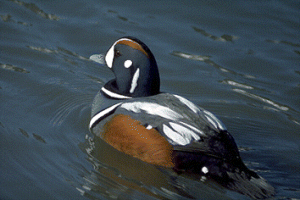Harlequin Duck, Histrionicus histrionicus
The boldly patterned male harlequin duck may appear conspicuous at first sight, but its colouring actually blends in remarkably well with the lights and darks of the rushing water where it feeds. The male’s head, neck, wings and back are slaty blue-grey, while its flanks are a rich chestnut-red colour. A black stripe runs along the top of its head, and is bordered by a chestnut line that fades to a white crescent around the front of its face. Several other white markings, all edged with black, are found on the wings, below the tail, on the side of the neck, behind the eye and around the base of the neck, forming a collar. The smaller female has a dark grey-brown body and a brown head with three indistinct white facial markings that are similar to those of the male. Harlequin ducks retain the same appearance throughout the year, with many people calling them “Lords and Ladies” in reference to their elegant plumage.
The harlequin duck is the only duck in North America – and one of only four in the world – that specializes in feeding in fast water, particularly in turbulent, rock-studded rivers that drain lakes and are rich in invertebrate life. When searching for food, it walks along the bottom of fast-flowing streams, using its bill to search among the rocks for insect larvae. It usually nests close to water, building its nest on the ground in a clump of bushes or occasionally in a rock crevice, tree cavity or old puffin burrow. The nest is made of dry plants that are arranged in a circular pattern to a height of 5 to 8 cm, and is lined with fine grass. After the 6-8 eggs are laid, the female plucks fine, soft feathers from her belly and places this down around the eggs. She incubates the eggs for 28-32 days, while the male leaves to moult and feed in other areas, reducing the number of ducks feeding in one area and thus probably increasing survival rates.
Although harlequin ducks breed in fresh water, like many Arctic ducks they spend the winter on the ocean. Harlequin ducks are excellent mariners. They are expert divers, an adaptation that is useful for wintering in stormy waters. They play in the surf, using both their wings and their feet to dive through waves, and also demonstrate a great ability to navigate through the roughest seas. Because they expend large amounts of energy swimming in rough water, these ducks often perch on exposed rocks to rest, unlike other sea ducks that typically rest right on the water. Harlequin ducks feed in small groups close to the shore, working their bills around and under stones to find the crustaceans, molluscs, and chitons that make up their diet. They are the only ducks that are capable of pulling limpets and chitons off rocks, which they do by prying with the hard “nail” on the tip of their bill. When harlequin ducks are in the air, their flight is characteristically swift and erratic, and their voice is a shrill whistle that resembles the squeak of a mouse.
Harlequin ducks breed in Siberia and in mountain rivers through Alaska and the western provinces and states, possibly as far south as California. They also breed in the eastern Arctic on Baffin Island, the Ungava peninsula and Greenland. This eastern population was listed as Endangered in Canada in 1990, because the population size has dropped rapidly in recent years to less than half of what is required for the duck to survive in the long term. It is threatened by hunting, oil spills, and human disturbance through low-level flying, tourism and insect control programs, which reduce the amount of larvae available for it to feed on. Its preferred habitat is also being drastically reduced by development activities such as hydroelectric projects, which destroy the fast-flowing rivers where it breeds. The western populations of harlequin ducks, which are not endangered, winter along the Pacific coast of the United States to California, while those in the east winter in the Atlantic, from the coast of Labrador south to Massachusetts.

